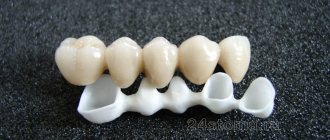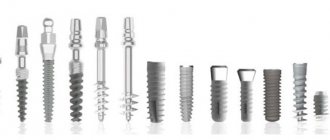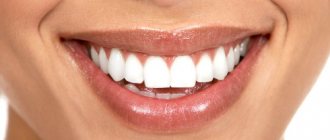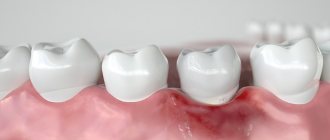A dental crown is a special type of dental structure that is used to solve the problem of missing teeth in a row. Crowns are installed not only when a tooth is lost, they will help restore the functionality and aesthetics of the dentition even if the tooth is severely damaged by caries. In this article we will look in detail at what dental crowns are, what types of them exist, and how dentures are installed and fixed on teeth. We will separately consider possible complications after installing a crown, as well as the cost of services in dentists in St. Petersburg.
What is a dental crown, when is its installation indicated?
A crown is an orthodontic product used in dentistry to restore all functions of a tooth, as well as its shape. Crowns for installation on teeth are made in the laboratory and can be fixed in different ways - with cement, with the help of locking fasteners, with implants. The main difference between crowns and veneers and fillings is that they completely cover the visible part of the tooth.
Installation of crowns is a restoration procedure that has its own range of indications:
1. Crowns are installed on a tooth if its hard tissues are destroyed by more than fifty percent, but the root is intact and has retained its vitality.
2. If there are aesthetic defects that cannot be corrected by other methods, installing crowns may be the best option. Prosthetics with a crown will help hide defects such as improper growth of the dental unit, malocclusions that cannot be corrected by wearing braces.
3. Installation of crowns on teeth is also indicated for abnormal abrasion of tooth enamel. The installed structure will reliably protect the hard tissues of the tooth from harmful external factors and destruction.
4. For some periodontal diseases. Periodontitis and periodontal disease at a certain phase of development lead to the appearance of tooth mobility. To protect your teeth from falling out, you can install temporary crowns.
Crowns are also installed on teeth in cases where restoration with veneers is impossible, in the presence of visible interdental spaces, or in case of tooth loss as a result of injury.
When can you start eating
Dentists do not advise starting to eat earlier than 2-3 hours after surgery. Implantation of an implant involves cutting soft tissues with further sutures, so eating can cause the sutures to diverge and allow bacteria to enter the wound. If bacteria enters the bloodstream, a person can face very serious complications.
If the patient has undergone express or basal implantation, you can start eating soft food an hour after completion of the procedure. However, in any case, it is important to wait until the anesthesia wears off. This is explained by the fact that due to a decrease in the sensitivity of soft tissues, you can accidentally burn yourself, bite your tongue or injure your cheek.
If the patient was under general anesthesia during implantation, you can eat no earlier than after 4-5 hours. At the same time, you should forget about solid food for a while. It is recommended to consume soups, purees and other soft foods, preferably at medium temperature.
Types of crowns for installation on teeth
The classification of crowns into different types is carried out according to the material of their production. You can install structures on your teeth from:
- Alloys of precious and base metals;
- Ceramics;
- Metal ceramics;
- Zirconium dioxide.
Each type of crown for installation on teeth has its pros and cons. For example, metal structures are highly durable, but their aesthetics are extremely poor. Therefore, they will be the best option for installation on chewing teeth that are not included in the smile area.
For restoration in the area of the front teeth, it is optimal to install ceramic and zirconium crowns on the teeth. These materials have a transparency level that is almost similar to natural tooth enamel, which is why crowns made from them look as natural as possible.
Before prosthetics, the orthodontist should offer you several options for crowns made of different materials and advise you in detail on their characteristics and cost.
Crowns are also graded into different types according to production technology - for example, classic crowns are made on the basis of impressions taken from the patient’s teeth. Crowns made of ceramics and zirconium dioxide can be produced using innovative CAD/CAM technology. This method of making crowns involves the use of computer modeling, and the prosthesis itself is machined using special milling equipment, which allows it to achieve the correct shape and precise fit to the natural tissues of the oral cavity.
The type of attachment of crowns may also vary. The traditional option involves the use of dental cement, which coats the prosthesis from the inside. But it is also possible to install crowns on locks and on implants. Crowns on implants will be the most expensive option, but this type of prosthetics has many advantages: the most aesthetic and reliable result, no need for preliminary grinding of teeth.
The type of crowns to be installed on the teeth, the method of fastening them - all these details are discussed with the patient during a consultation in dentistry and are necessarily prescribed in the treatment plan and in the contract.
Installing crowns is a multi-stage procedure and at each stage of treatment the doctor will perform a certain set of actions. The next section of our article is devoted to an overview of all stages of installing crowns on teeth.
What should be the care in the first days after implantation?
The most important period after implant installation is the first 14 days. During this time, everything should be done to protect the open wound from infection, which can cause inflammation.
Basic rules to follow immediately after the procedure:
- in the morning, before bed and after meals, do mouth baths with an antiseptic prescribed by your doctor;
- For cleaning, use a soft brush, do not touch the implantation area, and avoid vigorous rinsing before removing the sutures;
- clean the interdental spaces from food debris with floss;
- To relieve swelling, use ice compresses according to the regimen recommended by the dentist;
- It is advisable to sleep on the side opposite the side of implantation in the first days.
Changes also need to be made to your diet. You can eat soft food at a comfortable temperature two to three hours after the operation, when the anesthesia wears off. You need to chew on the opposite side, while excluding hard, hot, spicy foods.
Overview of the main stages of installing crowns on teeth
As we noted above, the procedure for installing crowns on teeth is a multi-stage process. It is important to carry out each stage of treatment efficiently and carefully in order to eliminate possible complications in the future. Below we will look at all the stages of the process of installing a crown on your teeth.
Diagnostics
Diagnostic measures are carried out during the initial visit to the orthodontist’s office. The doctor carefully examines and evaluates the condition of the teeth and soft tissues of the mouth, and also prescribes radiography, which allows you to see the condition of the canals and roots of the tooth. Based on the diagnostic data, a treatment plan is drawn up and crowns for installation are selected. The doctor consults the patient in detail on all the procedures that will need to be performed before installing the crown, and announces the total cost of treatment. If the patient agrees to install the proposed crowns, a contract is concluded.
Sanitation of the oral cavity
You cannot do without professional teeth cleaning before installing crowns. The procedure is necessary for the complete and high-quality elimination of all types of plaque and accurate selection of the shade of the future crown - it must be identical to the natural color of the enamel. Sanitation is not included in the price of crown installation and is paid separately.
Treatment
As a rule, crowns are most often installed on teeth that are severely damaged by caries. In order for the prosthesis to last a long time, the destroyed dental unit must first be treated, its natural crown restored, and also sharpened. The process always begins with dental treatment, during which:
1. All tissues affected by caries are drilled out;
2. The canals are processed and sealed.
Before installing crowns, many patients ask the question: will the nerve be removed from all the teeth that will support the prosthesis? The answer to this question is as follows: depulpation, of course, eliminates the risks of pulp burns and the subsequent development of inflammation under the crown, but at the same time it makes the tooth more fragile and vulnerable to external factors.
Therefore, experienced and qualified dentists perform depulpation of abutment teeth before installing a crown only if there are certain indications, including:
- The pulp cavity is of considerable size;
- Excessively low crown part of the tooth.
Single-rooted dental units are usually also depulped. If it was decided to preserve the nerve in the tooth, its preparation is carried out using an anesthetic and always under cooling to prevent overheating of the pulp.
A high-quality root canal treatment is essential before crowns are placed. The canal cavities must be cleaned and treated with an antiseptic solution, and then properly sealed. Errors in endodontic treatment are the most common cause of complications after crown installation!
Preparation of abutment teeth
Preparation - this stage cannot be excluded from the list of preparatory measures for installing crowns. The need for preliminary grinding is explained by the fact that the natural shape of the teeth with natural irregularities does not allow for a tight fit of the crown to the enamel. The slightest gaps between the installed structure and the natural tissues of the tooth will interfere with the strong fixation of the crown, and will also create a favorable environment for the development of caries under the crown.
By grinding the tooth, the dentist will give it the shape that will allow you to correctly and securely install the crown. The preparation of teeth for the installation of a crown can be carried out using various types of specialized instruments: turbine or laser units, ultrasonic equipment.
The type of equipment for grinding abutment teeth for crown installation is determined based on the characteristics of the clinical case. If teeth with removed pulp are ground, anesthesia is not used. For living teeth, anesthesia is mandatory. After the dentist gives the supporting teeth the shape necessary for high-quality installation of the crown, an impression is taken from them, and then the ground teeth are covered with a temporary prosthesis. Grinding the teeth makes them vulnerable to the action of pathogenic microorganisms, installing temporary crowns will protect the teeth from destruction, and in addition, the prosthesis will hide the defect in the dentition from prying eyes until a permanent orthodontic structure is installed.
Taking an impression
Taking an impression before installing crowns on the teeth is necessary to create an accurate model from which the prosthesis will be made. The impression for making a crown must be of high quality and meet a number of requirements: Exactly repeat the anatomical relief of the oral cavity; The cast material should not shrink or deform over time.
To create high-quality permanent structures, which include dental crowns, several impressions are made and usually special silicone-based masses are used for this purpose. If the permanent crown will be made using CAD/CAM technology; taking impressions is not required, the computer program will scan the patient’s jaws and transfer the images to the equipment, which will make a model of the prosthesis and then the crown itself. CAD/CAM technology is used in the production of metal-free crowns.
Crown production, fitting, permanent fixation
The finished impressions are sent by the orthopedist to the laboratory and the technician will create a crown based on them. The process of making a crown is not fast. Therefore, during prosthetics, temporary dentures are used, which are put on the ground teeth for the entire time period that is necessary for the production of a permanent crown. As soon as the crown is ready, the patient is invited to try it on.
The method of fitting will depend on the type of prosthesis. For example, metal crowns can be tried on, the bite adjusted as needed, and immediately fixed with cement. Trying on metal-ceramic crowns will be a longer and more complex process: first, a ready-made metal frame will be applied, then the accuracy of the fit of the finished prosthesis with the applied finishing ceramic coating will be checked.
The main criterion that an orthopedic doctor takes into account when trying on a crown is the correctness of the bite. If the pressure is uneven, the daily use of the installed crown will be inconvenient, in addition, the service life of the prosthesis as a whole will be significantly reduced.
When trying on, such points as the correct selection of the color of the crown, the density of contact with adjacent teeth (dental floss is used to check), and the tightness of the marginal fit of the prosthesis are also taken into account. If the fitting does not reveal any inaccuracies or errors in the manufacture of the prosthesis, the crown is placed on the tooth and firmly fixed to it using a specialized cement composition. It covers the inner surface of the structure.
The installed crown is exposed to light radiation, which accelerates the hardening of the cement mass. After this, the doctor will remove excess composition to prevent it from getting on the soft tissues of the oral cavity. The cement mass is a rather caustic substance that can burn sensitive mucous membranes. The crown installation process ends with detailed consultation of the patient on the care of the installed prosthesis.
What are the dangers of improper care after prosthetics?
Bad breath and visible plaque are only superficial manifestations of poor hygiene. In fact, the consequences are much more serious:
- Plaque, accumulating near the surface of the gums, contributes to the formation of tartar.
- Tartar, in turn, is a breeding ground for bacteria.
- The waste products of harmful microorganisms have a destructive effect on the natural tissues of teeth and soft tissues, and provoke inflammation of the gums.
- When the gum becomes inflamed, its structure becomes loose. Such gums are not able to protect the cervical area of the teeth.
- If left untreated, seemingly harmless inflammation of the gums leads to much more serious consequences - periodontitis, the formation of gum pockets.
Simply put, dental hygiene and oral health are inextricably linked.
When is it necessary to remove installed crowns?
Removing crowns is an undesirable event, but under a number of circumstances it cannot be avoided. You will definitely have to remove the installed crown if:
1. An inflammatory process has occurred under the installed crown. Most often this happens due to mistakes made during canal filling. If the diagnosis reveals the presence of inflammation, the installed prosthesis will have to be removed, the tooth treated, and then the crown put on again;
2. Mistakes were made when making a dental crown. If the installed crown interferes with chewing, speaking, or does not adhere to the cervical part of the tooth with insufficient density, it is removed;
3. Installed crowns must also be removed during planned replacement of structures. Crowns made of any materials have specific terms
operation, after which the prosthesis should be replaced with a new design. The installed crown must be removed urgently if the prosthesis has been damaged during use.
Why is implant care so important?
After installation of the artificial root, restoration and adaptation processes begin in the surrounding tissues. The body starts the osseointegration mechanism, and it is very important to eliminate all factors that could interfere with this. One of them is poor oral hygiene, which results in the accelerated proliferation of pathogenic bacteria. As a result, an inflammatory process - mucositis - can develop in the soft tissues surrounding the titanium rod. When it transfers to bone structures, peri-implantitis begins, which is fraught with rejection of the root substitute.
To prevent this from happening, you should familiarize yourself with how to care for implants before the operation and follow these recommendations after installation. This is important for everyone, but proper care is especially important for patients at risk. These include people with alcohol and nicotine addiction, diabetes, allergies, and immune deficiency.
Complications after crown installation
If mistakes are made during preparation for installing crowns or making a prosthesis, the risks of complications increase. Most often, complications after crown installation are as follows:
1. Stomatitis. Prosthetic stomatitis occurs due to the fact that the crown puts increased pressure on the sensitive mucosa. This excessive pressure leads to impaired blood circulation in the area where the crown is installed and the gradual death of tissue.
2. Caries on dental units that support orthodontic structures. The disease can be caused by poor quality preparation for crown installation, if the recommendations of an oral care specialist are not followed.
3. Allergic reactions. They usually manifest themselves immediately after fixing the crown. Most often, allergic reactions occur during the installation of metal prostheses, therefore, even at the stage of preparing prosthetics, it is important to exclude the patient’s individual intolerance to metals and their alloys.
Less commonly, after the installation of crowns, a complication such as galvanic syndrome may occur. It is observed when there are dentures made of different metal alloys in the patient’s oral cavity. With galvanic syndrome, the patient may experience a pronounced metallic taste in the mouth, severe and frequent headaches, and the crown may change color.
If you experience any complication after installing crowns, you should contact your doctor immediately. To eliminate negative reactions and pathological processes under the crown, it is removed, appropriate treatment is carried out and then prosthetics are repeated.
The best way to avoid complications after installing a crown is to wisely choose a dental clinic for prosthetics.
Is it possible to eat immediately after dental implantation?
Straightaway
You can't eat
after surgery . The rule is due to several reasons:
- Food can get into the wound (fraught with complications in the postoperative period);
- While anesthesia is still in effect, it is easy to bite your cheeks, lips, or tongue. Numb tissue will not signal whether the food is hot or cold. It is impossible to estimate the correct temperature of food: you can get burned or injured.
It takes time not to disturb the tissues, to allow them to calm down a little after the surgical procedures. We'll have to be patient.
Cost of installing a crown on teeth
Only an orthodontist can tell you the exact price for installing a crown after an examination and diagnosis. The exact cost of the design depends on a number of factors: the characteristics of the clinical case, its complexity, the material and production technology of the prosthesis. Separately, you will need to pay for services for preparing for prosthetics and the cost of a temporary prosthesis.
Want to know the cost of installing a crown? Sign up for a consultation at our dental clinic in St. Petersburg - “Uni Dent”.
Example of a daily diet
It’s easier to eat after dental implantation if you have a cheat sheet - a menu for the day. It should be varied and recommended in the postoperative period. Here is an approximate daily diet:
- Breakfast 1: oatmeal with banana slices, butter. Boiled in milk or water. Warm green tea.
- Breakfast 2: cottage cheese casserole with sour cream. Herbal tea is not hot.
- Lunch 1: vegetable puree soup. Meatballs with mashed potatoes. Uzvar.
- Lunch 2: chicken broth with mashed potatoes. Boiled cauliflower puree, broccoli, steamed meatballs. Pumpkin juice.
- Dinner 1: Steamed fish cutlet with a side dish of rice flakes. Kefir.
- Dinner 2: chicken cutlet with chopped buckwheat porridge. Compote.
- Snacks: any baby food, cereal, fruit puree, yoghurt.
It is important not to starve during the recovery period; always have on hand what you are allowed to eat after dental implantation.










